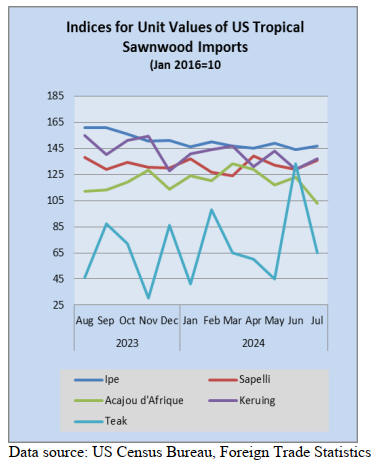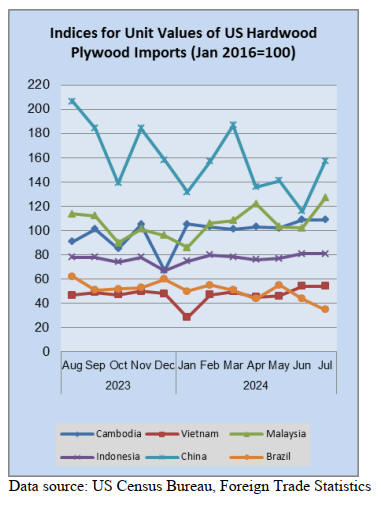|
Report from
North America
US manufacturing mired in weakness
US manufacturing contracted at a moderate pace in
August amid some improvement in employment, but a
further decline in new orders and rise in inventory
suggested factory activity could remain subdued for a
while.
The monthly survey from the Institute for Supply
Management (ISM) also showed manufacturers continuing
to pay higher prices for inputs last month. The ISM said its
manufacturing PMI rose to 47.2 last month from 46.8 in
July, which was the lowest reading since November.
A PMI reading below 50 indicates contraction in the
manufacturing sector, which accounts for 10.3% of the US
economy.
The PMI remained below the 50 threshold for the fifth
straight month, but was above the 42.5 level that the ISM
said over time indicates an expansion of the overall
economy.
Of the 18 manufacturing industries surveyed, the Furniture
and Related Products sector was among five that reported
growth in August. The Wood Products sector was among
12 industries that reported contraction.
“Interest rate cuts may not happen soon enough to have an
impact this year,” reported one Wood Products executive.
“High interest rates are curtailing consumer spending on
large discretionary spending for furniture, cabinetry,
flooring and decorative trim, which has affected our
industry sales potential. At the same time, pent-up demand
seems to be growing for housing and remodeling.”
See: https://www.ismworld.org/supply-management-news-and-
reports/reports/ism-report-on-business/pmi/october/
Housing leaders laud US Federal Reserve’s biggest
rate cut in 16 years
The US Federal Reserve followed through with its much-
anticipated interest rate reduction as expected by many
Wall Street analysts. On September 18 the Federal
Reserve approved a fifty-basis rate cut (one basis point is
equivalent to 0.01%), marking its first reduction since the
pandemic, and the largest single rate cut in 16 years.
Mortgage rates started declining ahead of the Fed's
decision, giving a boost to the residential housing market.
The National Association of Realtors chief economist
Lawrence Yun commented on the Federal Reserve's rate
cut move saying, "The Fed's half-point rate cut decision is
the beginning of six to eight rounds of further rate cuts
well into 2025. Mortgage rates have already anticipated
the Fed's likely path. That is why the 30-year rate has
fallen by 150 basis points from early in the year to today.
Consumers who were priced out due to earlier higher
mortgage rates could now be back in the market."
The Mortgage Bankers Association chief economist also
commented, "Mortgage rates likely had this cut - and this
expected rate path - priced in, and lower mortgage rates,
now close to 6%, have resulted in much more refinance
and some additional purchase activity in recent weeks. We
do expect that if mortgage rates remain near these levels, it
will support a stronger than typical autumn housing
market and suggest that next spring could see a real
rebound in activity."
See: https://www.worldpropertyjournal.com/real-estate-
news/united-states/washington-dc-real-estate-news/real-estate-
news-federal-reserve-september-2024-rate-cut-data-fomc-data-
lawrece-yun-mike-fratantoni-national-association-of-realtors-
mortgage-bankers--14237.php
US single-family housing starts surge
US single-family homebuilding rebounded sharply in
August, but a moderate increase in building permits
suggested that the momentum was unlikely to be sustained
against the backdrop of a rising supply of new homes on
the market.
Single-family housing starts, which account for the bulk of
homebuilding, surged 15.8% to a seasonally adjusted
annual rate of 992,000 units last month, the Commerce
Department's Census Bureau said. Data for July was
revised higher to show starts at a rate of 857,000 units
instead of the previously reported 851,000 pace. Single-
family home building had declined for five straight
months after a surge in mortgage rates in spring weighed
on home sales, resulting in excess supply of newly built
houses.
Total housing starts (single-family and apartments) in
August were at a seasonally adjusted annual rate of
1,356,000. This is 9.6% above the revised July estimate of
1,237,000 and is 3.9% above the August 2023 rate of
1,305,000.
Single-family starts jumped 18.9% in the densely
populated South, where activity was likely weighed down
by Hurricane Beryl in July. Starts rose 47.4% in the
Northeast and increased 11.6% in the Midwest, which is
considered the most affordable region. Homebuilding rose
2.8% in the West.
Canadian housing starts fell sharply in August, dropping to
their lowest level in nine months due to a pullback in the
construction of multi-unit dwellings, like condominiums
and row houses. Canada Mortgage and Housing Corp. said
that housing starts in August across the country totaled
217,405 units on a seasonally adjusted, annualized basis,
or a 22% drop from the prior month. The August result
missed market expectations by a wide margin - with
traders looking for housing starts to hit 245,000, according
to economists at Bank of Nova Scotia.
See:
https://www.census.gov/construction/nrc/current/index.html
and
https://www.cmhc-schl.gc.ca/professionals/housing-markets-
data-and-research/housing-data/data-tables/housing-market-
data/monthly-housing-starts-construction-data-tables
Home sales slump in August
Sales of previously owned homes in the United States fell
sharply in August, despite mortgage rates falling that
month. But much more housing demand will likely be
unleashed onto the market after the Federal Reserve
finally cut interest rates this month for the first time in four
years — and signaled more rate cuts by year’s end.
Existing home sales, which make up the vast majority of
the market, fell 2.5% in August from the prior month to a
seasonally adjusted annual rate of 3.86 million, the
National Association of Realtors reported. That was the
lowest August sales level since 1995, NAR chief
economist Lawrence Yun said on a call with reporters.
Meanwhile, home prices continued to climb last month,
with the median price of an existing home rising 3.1% to a
new record high of US$416,700, which marked the 14th
straight year-over-year increase.
See: https://www.nar.realtor/research-and-statistics/housing-
statistics/existing-home-sales
US job growth picks up moderately and unemployment
rate falls
US employment increased less than expected in August,
but a drop in the jobless rate to 4.2% suggested an orderly
labour market slowdown.
The below-expectations rise in non-farm payrolls reported
by the Labor Department likely reflected a seasonal quirk
that tends to push the initial August print lower.
Nonetheless, labour market momentum is slowing, with
the closely watched employment report also showing the
economy added 86,000 fewer jobs in June and July than
previously reported.
Employment gains in August were led by the construction
sector, which added 34,000 jobs, driven by heavy and civil
engineering construction and non-residential specialty
trade contractors, though manufacturing employment
dropped by 24,000.
See: https://www.bls.gov/news.release/empsit.nr0.htm
US consumer sentiment rises for second month
Americans' outlook on the economy improved for the
second straight month in September, bolstered by lower
prices for long-lasting goods such as cars and furniture and
the prospect of interest rate cuts by the Federal Reserve.
The University of Michigan's consumer sentiment index
ticked up to 69 in its preliminary reading, its highest level
since May and up from 67.9 in August. The gain was
driven by consumers' perceptions that prices have
improved for durable goods, the report from University of
Michigan said.
The survey bottomed out in June 2022, when inflation
peaked at 9.1%, and has since risen by about 40%, though
it remains significantly below pre-pandemic levels. The
long-term average for the index is nearly 85, according to
Capital Economics.
Rising consumer confidence can sometimes signal a
greater willingness to spend, though Americans have
largely continued to spend at a healthy pace even though
their confidence, as measured in surveys, has been
subdued.The economy expanded at a 3% annual rate in the
April-June quarter, and retail spending picked up in July.
Yet Americans have been saving less and running up more
credit card debt, which has raised concerns among some
economists that consumers will soon have to cut back,
potentially slowing growth.
See: http://www.sca.isr.umich.edu/

Note: the doubling of the unit value for teak may be a statistical
error. Use with caution.

Disclaimer: Though efforts have been made to ensure
prices are accurate, these are published as a guide only.
ITTO does not take responsibility for the accuracy of this
information.
The views and opinions expressed herein are those of
the correspondents and do not necessarily reflect those
of ITTO
|